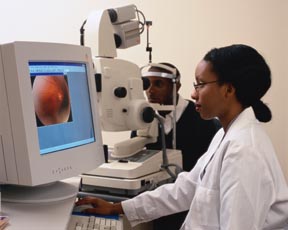Researchers at the University of Alabama at Birmingham hope to one day use fluorescent light bulbs to slow nearsightedness, which affects 40 percent of American adults and can cause blindness.
 In an early step in that direction, results of a study found that small increases in daily artificial light slowed the development of nearsightedness by 40 percent in tree shrews, which are close relatives of primates.
In an early step in that direction, results of a study found that small increases in daily artificial light slowed the development of nearsightedness by 40 percent in tree shrews, which are close relatives of primates.
The team, led by Thomas Norton, Ph.D., professor in the UAB Department of Vision Sciences, presented the study results today at the 2012 Association for Research in Vision and Ophthalmology annual meeting in Ft. Lauderdale.
People can see clearly because the front part of the eye bends light and focuses it on the retina in back. Nearsightedness, also called myopia, occurs when the physical length of the eye is too long, causing light to focus in front of the retina and blurring images.
Myopia has many causes, some related to genetic inheritance and some to the environment. Research in recent years had, for instance, suggested that children who spent more time outdoors, presumably in brighter outdoor light, had less myopia as young adults. That raised the question of whether artificial light, like sunlight, could help reduce myopia development, without the risks of prolonged sun exposure, such as skin cancer and cataracts.
“Our hope is to develop programs that reduce the rate of myopia using energy efficient, fluorescent lights for a few hours each day in homes or classrooms,” said John Siegwart, Ph.D., research assistant professor in UAB Vision Sciences and co-author of the study. “Trying to prevent myopia by fixing defective genes through gene therapy or using a drug is a multi-year, multimillion-dollar effort with no guarantee of success. We hope to make a difference just with light bulbs.”
Sorting through theories
Work over 25 years had shown that putting a goggle over one eye of a study animal, one that lets in light but blurs images, causes the eye to grow too long, which in turn causes myopia. Other past studies had shown that elevated light levels could reduce myopia under these conditions, whether the light was produced by halogen lamps, metal halide bulbs or daylight. The current study is the first to show that the development of myopia can be slowed by increasing daily fluorescent light levels.
One prevailing theory on myopia-related shape changes in the eye is that they are caused by the blurriness of images experienced while reading or doing other near-work chores. Another holds some people develop myopia because they have low levels of vitamin D, which goes up with exposure to sunlight and could explain the connection between outdoor light and reduced myopia. A third theory, one reinforced by the current results, is that bright light causes an increase in levels of dopamine, a signaling molecule in the retina.
To test the theories, the team used a goggle that lets in light but no images to produce myopia in one eye of each tree shrew. They found that a group exposed to elevated fluorescent light levels for eight hours per day developed 47 percent less myopia than a control group exposed to normal indoor lighting, even though the images were neither more nor less blurry. They also found that animals fed vitamin D supplements developed myopia just like ones without the supplement. Given these results, the team is now experimenting with light levels and treatment times to see if a short, bright light treatment could be effective. They have also begun studies looking at the effect of elevated light on retinal dopamine levels as it relates to the reduction of myopia.
“If we can find the best kind of light, treatment period and light level, we’ll have the scientific justification to begin studies raising light levels in schools, for instance,” said Norton. “Compact fluorescent bulbs use much less electricity than standard light bulbs, and future programs raising light levels will have more impact the less expensive they are.”
